Looking for a student learning guide? It’s linked in the main menu for your course. Use the “Courses” menu above.
1. Introduction
When one species splits apart into multiple descendants — a process called adaptive radiation — we have descent with modification that runs in parallel lines. Tracing these modifications can provide us with evidence for evolution.
Let’s see how.
2. Adaptive Radiation and Homologous structures
When speciation repeats itself, you wind up with an evolutionary tree like the one shown below. The birds on the right side of the evolutionary tree live on the Galapagos islands, about 600 miles (1000 kilometers) off the coast of Ecuador. The bird on the left is their common ancestor.
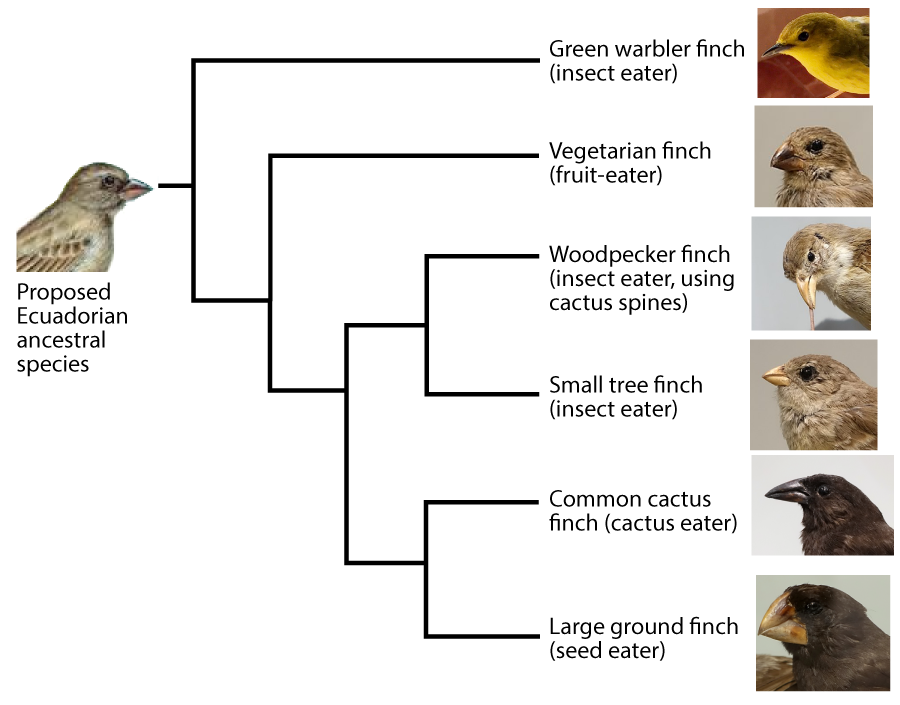 |
 |
| Evolutionary tree of the Galapagos finches | The Galapagos Islands |
Why is the process of one species splitting into multiple descendants called adaptive radiation? In this context, radiation means spreading out. In relationship to the Galapagos finches, the basic idea is this. After the birds first arrived from Ecuador (probably blown there by a storm), they were subject to natural selection in their new island environment. This led to the evolution of new adaptations, especially in the form of their beaks. As the birds spread from island to island, the process of natural selection and adaptation repeated itself. Eventually, you have an array of descendant species, each with a beak that’s adapted to a different food source.
Take a moment to study the diagram below.
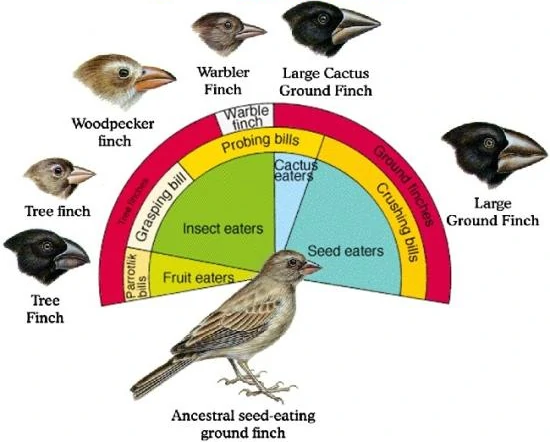
The beaks of the Galapagos finches are structures that have evolved different functions. In each species, there’s been descent with modification. But because of different types of natural selection, the modification is different in each case.
Structures that are inherited from a common ancestor are called homologous structures. The related noun is homology. Homology is a similarity in structure between parts of different species due to evolutionary differentiation from a corresponding part in a common ancestor (adapted from Merriam Webster).
How are the beaks an example of a homology?
- The beaks have a similar structure.
- They’re slightly different because natural selection caused each species to differentiate (which means “to become different.)
- They’re inherited from a corresponding part in a common ancestor.
Study the flashcards below.
3. Adaptive Radiation and Homologous Structures Flashcards
[qdeck qrecord_id=”sciencemusicvideosMeister1961-Adaptive Radiation and Homologous Structures (HS)”]
[h]Adaptive radiation and homologous structures
[i]
[q]Define adaptive radiation.
[a]Adaptive radiation is the process by which one ancestral species splits into multiple descendants.
[q]The diagram below shows the _________ ___________ of bears.
[a]The diagram below shows the adaptive radiation of bears.
[q]Connect the diagram below to the idea of adaptive radiation.
[a]The diagram shows adaptive radiation. One species evolved into several descendants, each with a unique beak adapted to a particular type of food.
[q]What are homologous structures?
[a]Homologous structures are structures that are inherited from a common ancestor.
[q]The beaks of the Galapagos finches are __________________ ______________.
[a]The beaks of the Galapagos finches are homologous structures.
[q]Define homology
[a]A homology is a similarity in structure between parts of different species due to evolutionary differentiation from a corresponding part in a common ancestor.
[q]The birds below are Hawaiian honeycreepers. Use the terms adaptive radiation and homologous to explain the diagram below.
[a]The Hawaiian honeycreepers evolved from a common ancestor through adaptive radiation. Their beaks are homologous.
[q]To say the the beaks of these Hawaiian honeycreepers are homologous means
[a]To say the the beaks of these Hawaiian honeycreepers are homologous means that they were inherited from a common ancestor, and have differentiated into different forms.
[q]Structures inherited from a common ancestor are called __________ ___________.
[a]Structures inherited from a common ancestor are called homologous structures.
[x][restart]
[/qdeck]
4. Homology as Evidence for Evolution
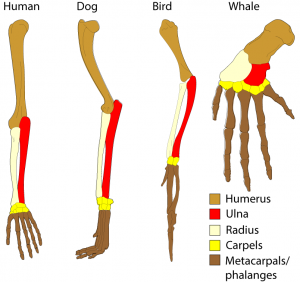
Let’s look at the bones that make up the forelimbs of humans, dogs, birds and whales. These structures, which make up the arm, forelimb, wing, and flipper of each respective animal, have the same underlying structure. They’re composed of the same bones.
 How do we know that they’re the same bones?
How do we know that they’re the same bones?
- First, because of their similar position and relationship to one another.
- Second, because they develop from the same tissue in the embryo of each animal. An embryo is an unborn or unhatched offspring that’s still in the process of development.
You can see this is the diagram to the right. Early in embryonic development, a patch of tissue forms a limb bud, circled in red. If you examined embryos from related species that were at the same developmental phase, you’d see that this tissue is identical in form. However, as the animal develops into its adult form, the limb bud differentiates into the form characteristic of its species.
Why are all vertebrate forelimbs composed of the same bones, and why do they develop from the same embryonic tissue? Because all of these animals share a common ancestor. Through adaptive radiation, the ancestral species split into several lineages. In each lineage, natural selection led to the development of unique adaptations shared by that evolutionary group.
Look again at the diagram showing homology in the forearms of various vertebrates.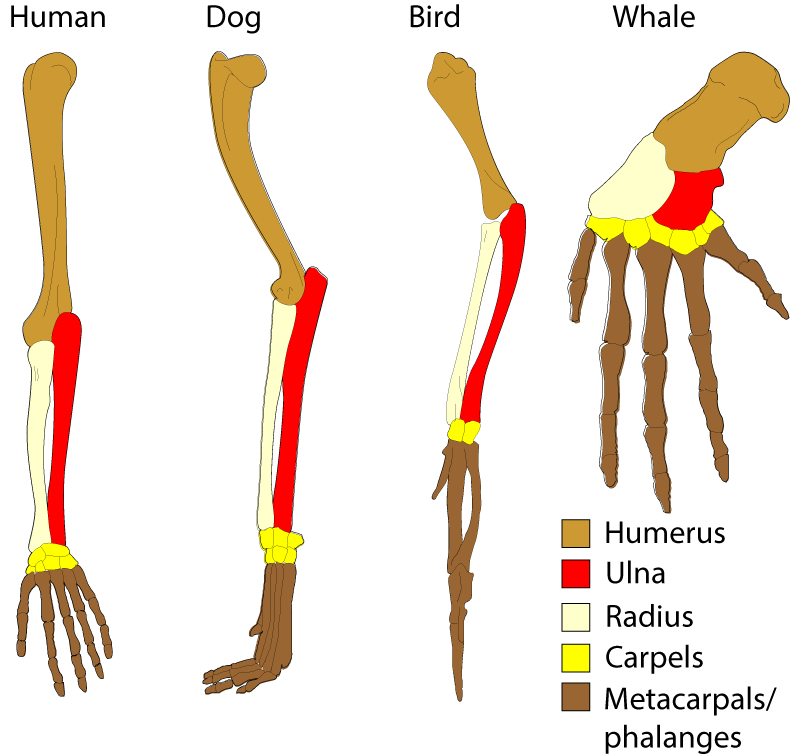
- In the group that led to whales, natural selection modified the forelimb into a flipper.
- In birds, natural selection modified the forelimb into a wing.
- In the group humans belong to, the forelimb evolved an opposable thumb and the ability to rotate our forearms and shoulders. This adaptation is found in all all primates, the order of mammals that humans are a part of. Other primates are monkeys and apes. Primate forearms are an adaptation for life in trees.
- In dogs and other carnivores, natural selection led to a forelimb adapted for running and capturing prey.
What was this common ancestor of humans, birds, whales and dogs like? It wasn’t some animal that mixed the features of humans, dogs, birds, and whales. Rather, the common ancestor of all of the four-limbed vertebrates (amphibians, reptiles, birds, and mammals) was a lobe-finned fish, similar to the extinct Eusthenopteron shown below.
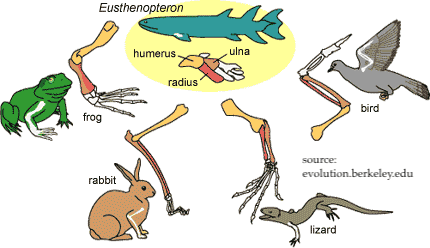
Looking at vertebrate forelimbs (as well as the beaks of the Galapagos finches), you can see why homologous structures have been compared to the musical form of “theme and variations.” This form, popular in classical music, takes a melody (the theme), and then modifies it (producing the variations). In evolution, the theme is the structure in the common ancestor; the variations are the specific adaptations in the descendants.
Why are homologous structures evidence for evolution? Because they confirm the claim of descent with modification. Homologous structures only make sense if seen as having evolved from a shared ancestor which diverged, over evolutionary time to form several related descendant species.
Let’s consolidate our understanding with flashcards, and then a quiz.
5. Checking Understanding: Adaptive Radiation and Homologous Structures
5a. Adaptive Radiation and Homologous Structures Flashcards
[qdeck qrecord_id=”sciencemusicvideosMeister1961-Homologous Structures as Evidence for Evolution (HS)”]
[h]Homologous structures as evidence for evolution
[q]How do we know that the forelimbs of vertebrates are composed of the same bones?
[a]We know that the forelimbs of vertebrates are composed of the same bones because of the bones’ similar position and relationship to one another, and because they develop from the same embryonic tissue.
[q]The forelimbs of vertebrates can be described as
[a]The forelimbs of vertebrates can be described as homologous structures.
[q]If a group of species share homologous structures, it’s evidence that …
[a]If a group of species share homologous structures, it’s evidence that they evolved from a common ancestor.
[q]Define homologous structure.
[a]Homologous structures are structures that are inherited from a common ancestor.
[q]Homologous structures are evidence of __________________ _______________ from a common ancestor. They’re also evidence of _______________ ________ ________________.
[a]Homologous structures are evidence of adaptive radiation from a common ancestor. They’re also evidence of descent with modification.
[/qdeck]
5b. Adaptive Radiation and Homologous Traits Quiz
[qwiz qrecord_id=”sciencemusicvideosMeister1961-Adaptive Radiation and Homologous Traits Quiz (HS)”]
[h]Adaptive Radiation and Homologous Traits
[i]Biohaiku
Homologous traits
Evidence of shared descent
From one ancestor
[q]When one species branches into two or more descendants, it’s called [hangman] [hangman].
[c]YWRhcHRpdmU=[Qq]
[c]cmFkaWF0aW9u[Qq]
[q]Adaptive radiation leads to two or more daughter species. As each species adapts to a different environment, different types of natural [hangman] will produce different adaptations in each descendant. In the case of these Galapagos finches, selection was for different types of [hangman].
[c]c2VsZWN0aW9u[Qq]
[c]YmVha3M=[Qq]
[q]The beaks below are modified forms of an ancestral structure in a shared ancestor. Therefore, we can say that they’re [hangman] structures.
[c]aG9tb2xvZ291cw==[Qq]
[q]We know that the forelimbs of birds and humans are [hangman] because they originate from the same tissue in the [hangman]
[c]aG9tb2xvZ291cw==[Qq]
[c]ZW1icnlv[Qq]
[q]In the diagram below, Eushenopteron is the [hangman] [hangman] of frogs, mammals, reptiles, and birds.
[c]Y29tbW9u[Qq]
[c]YW5jZXN0b3I=[Qq]
[q]The diagram below asserts that frogs, mammals, reptiles, and birds arose through adaptive [hangman] from a common ancestor.
[c]cmFkaWF0aW9u[Qq]
[q]Homologous structures are evidence of [hangman] with [hangman] from a common ancestor.
[c]ZGVzY2VudA==[Qq]
[c]bW9kaWZpY2F0aW9u
Cg==W3Jlc3RhcnRd[Qq]
[/qwiz]
6. Vestigial Traits are a special type of homology
6a. The Case of the Blind Cave Tetra
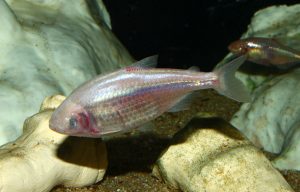
The Mexican tetra (Astyanax mexicanus) is a small, freshwater fish found in Eastern Mexico and Texas. In many areas, these fish live in water-filled caves. Some of these cave-dwelling populations have lost much of their vision. Some have lost all of their vision. Some have lost their eyes.
About 30 different cave populations have been identified. None have achieved the status of a distinct species. They can all interbreed with surface fish and produce fertile offspring.
Why would fish populations that live in caves lose their vision? There are a couple of reasons:
- Fish that live in caves can have mutations in genes that control the eyes’ structure or function, and suffer no loss in fitness. Thus, alleles for these mutations never get removed from these populations’ gene pools. Over time, these mutations can accumulate, causing average vision to get worse and worse from generation to generation.
- Eyes, and the nerve cells that support them, are complex structures. They require energy to build, maintain, and repair. In a situation where eyes are of little benefit, genes for smaller, less functional eyes can benefit survival. Instead of supporting eyes, energy can be devoted to other activities related to survival and reproduction.
So, instead of functioning eyes, cave fish often have just a trace of an eye left. Such a trace of an organ that once played a functional, adaptive role in an ancestor is called a vestigial trait. In more general terms, a vestigial trait is a structure that has lost its function, and only remains in a reduced form.
Why don’t these vestigial structures go away altogether? Sometimes they do. But there are a couple of reasons why a vestigial structure might be maintained.
- Once the structure becomes reduced, there’s little energy cost involved in maintaining it, and very little selective pressure to reduce it further.
- The genes for the structure might be involved in other functions or process that are still important to survival. It might be impossible to turn off these genes without having negative effects that would reduce the organism’s overall fitness.
How are vestigial traits evidence for evolution? They’re examples of descent with modification. The only reason why a vestigial trait would exist is that the ancestor of the species with the vestigial trait had a functioning version of the trait.
6b. Vestigial Traits Flashcards
[qdeck qrecord_id=”sciencemusicvideosMeister1961-Vestigial Traits Flashcards (HS)”]
[h]Vestigial Traits Flashcards
[q]Define vestigial trait.
[a]A vestigial trait is a structure that has lost its function, and only remains in a reduced form.
[q]For a vestigial trait to form, ___________ for genes that reduce a trait need to accumulate in a population’s _______ ________.
[a]For a vestigial trait to form, mutations for genes that reduce a trait need to accumulate in a population’s gene pool.
[q]The evolution of a vestigial trait can increase a species’ fitness. Why? Because when a structure doesn’t provide a(n) ___________, reducing it can allow energy to be spent on other structures or activities that benefit ____________ or ____________.
[a]The evolution of a vestigial trait can increase a species’ fitness. Why? Because when a structure doesn’t provide an advantage, reducing it can allow energy to be spent on other structures or activities that benefit survival or reproduction.
[q]Explain how natural selection could lead to the evolution of vestigial eyes in cave fish. List two reasons.
[a]First, in a fish that lives in a cave, mutations in genes for eyes that made vision worse would not be removed from the population’s gene pool. That’s because these mutations don’t decrease fitness. Second, reducing eyes when they’re not needed can be a benefit. That’s because reduction of the eyes allows the energy required for functioning eyes to be spent on other survival activities.
[q]How are vestigial traits evidence of evolution?
[a]Vestigial traits are evidence for evolution because they’re examples of descent with modification. The only reason why a vestigial trait would exist is that the ancestor of the species with the vestigial trait had a functioning version of the trait.
[/qdeck]
6c. Additional Examples of Vestigial Traits
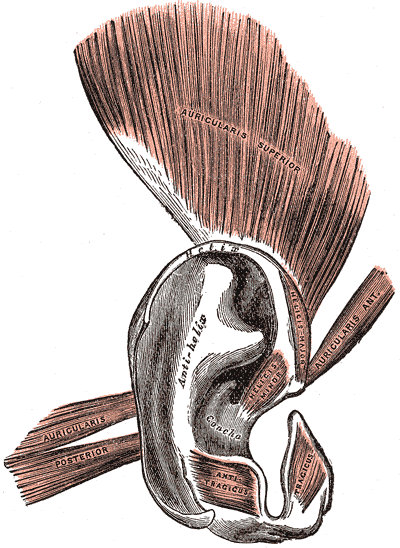 You don’t have to look very far to find other examples of vestigial traits.
You don’t have to look very far to find other examples of vestigial traits.
Our ears are wired up with muscles. But can you move your ears at will? Some people can wiggle their ears a bit, but most people can’t. And, even if you can wiggle your ears, you can’t move them in the way that other mammals like cats, dogs, rabbits and bats do. These animals move their ears to focus sound and to pinpoint the sound’s source. Ear movement helps predators be better at catching prey. It helps potential prey be better at avoiding being caught.
Human ear muscles are a vestigial trait. They’re evidence of descent with modification. In this case, we evolved from mammalian ancestors that had functioning ear muscles.
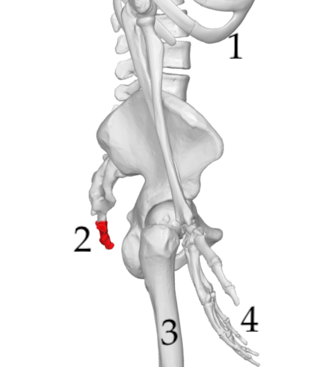
Here’s another human vestigial trait: Humans belong to group of mammals called primates. Most primates, such as monkeys and lemurs, have tails. Within the primates, we belong to the the family hominidae, or great apes. This group includes chimpanzees, gorillas, and orangutans. All of the species within this family lost their tails during the course of evolution. But we still have a vestige of a tail. It’s our coccyx, or tailbone. The coccyx is shown at “2” in the image to your right.
7. Vestigial Traits Quiz
[qwiz qrecord_id=”sciencemusicvideosMeister1961-Vestigial Traits Interactive Reading and Quiz (HS)”]
[h] Vestigial Traits: Checking Understanding
[i]Biohaiku
Vestigial traits
Structures without a function
Remnants of the past
[q labels = “top”]The diagram below shows the skeleton of a __________.We’ve already discussed above how the bones of the flipper at “b” are _______________ to the bones making up the __________ of other vertebrates. The bones at “c” are another homology. They’re the whale’s ______ bones. But their shrunken and reduced form indicates that these legs are, in modern whales, a ___________ structure.
[l]forelimb
[f*] Good!
[fx] No, that’s not correct. Please try again.
[l]homologous
[f*] Great!
[fx] No. Please try again.
[l]leg
[f*] Good!
[fx] No, that’s not correct. Please try again.
[l]vestigial
[f*] Excellent!
[fx] No, that’s not correct. Please try again.
[l]whale
[f*] Great!
[fx] No. Please try again.
[q] Study this reconstruction of whale evolution, and then proceed to the next card
[q labels = “top”]Whales evolved from four limbed mammalian ____________. As these mammals adapted to life in the ______, there was natural ____________ for a streamlined shape that reduced drag. In the water, the _______ limbs that were once useful for walking and running became a disadvantage. Any whale ancestor with smaller legs would have a survival _____________: it could swim faster and more ____________.
[l]advantage
[f*] Good!
[fx] No, that’s not correct. Please try again.
[l]ancestors
[f*] Good!
[fx] No. Please try again.
[l]efficiently
[f*] Excellent!
[fx] No. Please try again.
[l]hind
[f*] Great!
[fx] No. Please try again.
[l]selection
[f*] Correct!
[fx] No, that’s not correct. Please try again.
[l]sea
[f*] Excellent!
[fx] No. Please try again.
[q] Just to recap, both “b” and “c” in the diagram below are [hangman] to structures in other vertebrates. But while “b” is a structure that still has its function, “c” has evolved into a [hangman] structure.
[c]IGhvbW9sb2dvdXM=[Qq]
[f]IEV4Y2VsbGVudCE=[Qq]
[c]IHZlc3RpZ2lhbA==[Qq]
[f]IENvcnJlY3Qh[Qq]
[q] The vestigial leg bones of whales (at “C”) are evidence of their [hangman] with [hangman] from a four-legged mammalian ancestor.
[c]IGRlc2NlbnQ=[Qq]
[f]IEV4Y2VsbGVudCE=[Qq]
[c]IG1vZGlmaWNhdGlvbg==[Qq]
[f]IEdvb2Qh[Qq]
[q] In the diagram below, the vestigial trait is at number
[textentry single_char=”true”]
[c]ID I=[Qq]
[f]IEV4Y2VsbGVudC4gTnVtYmVyICYjODIyMDsyJiM4MjIxOyBpcyB0aGUgY29jY3l4LCBhIHZlc3RpZ2lhbCBzdHJ1Y3R1cmUgdGhhdCYjODIxNztzIGEgbGVmdG92ZXIgZnJvbSBvdXIgdGFpbC1iZWFyaW5nIHByaW1hdGUgYW5jZXN0b3JzLg==[Qq]
[c]IEVudGVyIHdvcmQ=[Qq]
[c]ICo=[Qq]
[f]IE5vLiBUcnkgdG8gaWRlbnRpZnkgdGhlIHBhcnQgdGhhdCYjODIxNztzIGEgcmVtbmFudCAob3IgdmVzdGlnZSkgb2YgYSBwYXJ0IHRoYXQgaGFkIGEgZnVuY3Rpb24gaW4gb25lIG9mIG91ciBhbmNlc3RvcnMu[Qq]
[q] In the diagram below, structures “3” and “4” are not considered to be [hangman] because they have a clear
[hangman].
[c]IHZlc3RpZ2lhbA==[Qq]
[c]IGZ1bmN0aW9u[Qq]
[q]One way for a structure to become vestigial is when ____________ occur in the genes for a structure, but with no resulting loss in evolutionary _____________. That could be because the structure no longer serves as an _____________. As a result, these mutations never get removed from the population’s ____________ pool.
[l]adaptation
[fx] No. Please try again.
[f*] Good!
[l]fitness
[fx] No, that’s not correct. Please try again.
[f*] Excellent!
[l]gene
[fx] No. Please try again.
[f*] Correct!
[l]mutations
[fx] No. Please try again.
[f*] Excellent!
[q]Structures can become vestigial because evolution has a kind of “[hangman] it or lose it” dynamic. Complex structures take [hangman] to build, maintain, and repair. If the structure doesn’t help a species survive, then the energy used to support that structure can be used for other activities or building other structures that increase an species’ evolutionary fitness.
[c]dXNl[Qq]
[c]ZW5lcmd5[Qq]
[q labels = “top”]Why don’t vestigial structures entirely disappear? One reason is that once a structure becomes reduced, there’s little _____________ required to maintain it. Therefore, there’s very little natural ___________ to reduce it further. A second reason is that the genes for that structure, or the structure itself, might be related to other _____________ that are essential to the organism’s survival. In that case, complete disappearance of a structure would reduce evolutionary ___________.
[l]energy
[fx] No. Please try again.
[f*] Correct!
[l]fitness
[fx] No. Please try again.
[f*] Great!
[l]functions
[fx] No, that’s not correct. Please try again.
[f*] Great!
[l]selection
[fx] No. Please try again.
[f*] Excellent!
[q]Structures in human beings like our tail bones or ear muscles are [hangman] structures. That means that they’re structures that have lost their [hangman].
[c]dmVzdGlnaWFs[Qq]
[c]ZnVuY3Rpb24=[Qq]
[q]Vestigial structures are evidence of what Darwin would have called [hangman] with [hangman]. The only possible reason why a species has a vestigial structure is that the structure was inherited from an [hangman] who used the structure
[c]ZGVzY2VudA==[Qq]
[c]bW9kaWZpY2F0aW9u[Qq]
[c]YW5jZXN0b3I=[Qq]
[/qwiz]
Links
- The Fossil Record (HS Level): the next tutorial in this module.
- Evidence for Evolution (HS) Menu
